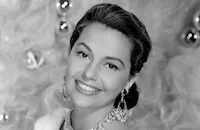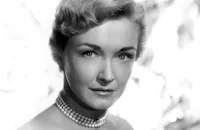Sombrero

Brief Synopsis
Cast & Crew
Norman Foster
Ricardo Montalban
Pier Angeli
Vittorio Gassman
Yvonne De Carlo
Cyd Charisse
Film Details
Technical Specs

Synopsis
In Columba, Mexico, mischievous cheese-maker Pepe Gonzales commits his annual prank of drawing mustaches on the photographs of the town's beauty contestants to protest the exclusion of María, a low-born woman who lives by the river. When María's picture is mysteriously entered in the contest, she wins by a landslide, but fearing the reaction of the townswomen, the mayor instead names the socially prominent Elena Cantú queen of the carnival. That night, wealthy Alejandro Castillo visits María, his secret love, and admits that he entered her picture in the contest. Meanwhile, Pepe decides to become a hero by retrieving the bones of the great Don Romulo Balderas from the cemetery in the nearby town of Milpa Verde, which is engaged in a bitter feud with Columba. His friend Rubén, a candy-maker, agrees to join him, but they are caught trying to break into Don Romulo's tomb by Eufemia Calderón, who calls for help after Pepe kisses her. The two friends make a narrow escape, and Rubén's arm is broken when he falls from his horse. Pepe takes Rubén to see Mariano Martínez, known as Little Doctor, who has just advised Alejandro to consult a specialist in Mexico City about his persistent headaches. Alejandro and Rubén go to Mexico City, and while selling his candy at the bullfight, Rubén is immediately smitten by Lola, sister of the arrogant gypsy matador Gitanillo de Torrano. After the fight, the love-struck Rubén calls on Lola, but she is too afraid of her cruel brother to consider romance. Back in Columba, Pepe tells his friends that he is in love with Eufemia and plans to court her. That weekend, armed with an enormous wheel of his family's renowned goat cheese, Pepe approaches Don Homero Calderón's home, where Eufemia's birthday party is taking place. Pepe quickly charms his way into Don Homero's good graces and begins wooing Eufemia, but is forced to flee when a guest recognizes the fine cheese Pepe brought as being from Columba. Meanwhile, Little Doctor inspects the X-rays taken in Mexico City and sadly informs Alejandro that he has only a short time to live, adding that he will go blind right before the end. Alejandro swears Little Doctor to secrecy, then goes to María and tells her everything. Certain that she would never be accepted because of her illegitimacy, María insists that Alejandro obey his powerful father and marry Elena. Alejandro reluctantly goes through with the wedding, and the couple leave on their honeymoon as Maria sadly watches from a nearby rooftop. Pepe continues his clandestine courtship of Eufemia, but she says their situation is hopeless as long as the feud continues. Rubén returns to Mexico City and visits Lola, and she explains that Gitanillo is so possessive because he superstitiously believes that he will die if his sister marries. Lola tries to defy her brother, but when he strikes her and threatens Rubén, Lola seeks help from a sympathetic fortune teller, who gives her a voodoo doll. The following day, while in the ring, Gitanillo sees Rubén and determines to kill him. Desperate to stop him, Lola throws the doll into the ring, and Gitanillo is gored to death by the bull. In Columba, Alejandro and Elena return from their honeymoon, and Elena confides to her mother that Alejandro has refused to consummate their marriage. Alejandro goes to María and gives her a locket with a note in it, instructing her to take it to his father after his death. Alejandro suddenly loses his vision and is taken home, but Elena coldly refuses to send for the priest while María is there. Alejandro dies, and María is ordered by his father, Don Carlos, to leave the valley. She gives Don Carlos the locket, and he reads the note, which speaks of Alejandro's love for María and bequeaths to her a large inheritance. When María declines the money, Don Carlos asks her forgiveness and begs María to live with him as his daughter. Meanwhile, Lola remains haunted by Gitanillo's death, but after spending some time alone on a mountaintop, she overcomes her guilt and is able to be happy in her marriage to Rubén. Later, Pepe challenges the town of Milpa Verde to a cockfight, wagering his family's cheese against the remains of Don Romulo. Although Father Zacaya is appalled at the thought of a cockfight, he helps Pepe disguise the prize cock he had "borrowed" earlier from Don Homero. The day of the contest, however, Pepe's ruse is discovered, and Father Zacaya forfeits the contest. As the citizens of Milpa Verde eagerly dismantle a tower of cheese, they discover a magnificent statue of Don Romulo, which has been donated by Eufemia and Don Carlos. Father Zacaya blesses Pepe and Eufemia's engagement, and with the feud over at last, everybody celebrates.

Director

Norman Foster
Cast

Ricardo Montalban

Pier Angeli

Vittorio Gassman

Yvonne De Carlo

Cyd Charisse

Rick Jason

Nina Foch

Kurt Kasznar

Walter Hampden
Thomas Gómez
José Greco

John Abbott
Andrés Soler
Fanny Schiller
Luz Alba
Rosaura Revueltas

Alfonso Bedoya
Jorge Treviño
Tito Novaro
Manuel Arvide
Felipe De Flores
Beatriz Ramos
Florencio Castelló
Arturo Rangel
Salvador Báguez
Juan Duval
Rita Conde
Louise De Carlo
Gabrielle Roussillon
Tom Hernández
Orlando Beltrán
George Derrick
Carlos Barbé
Eduardo Cansino
Miguel Contreras
Alma Beltran
Amapola Del Vando
Pilar Del Rey
Dorita Pallais
Delmar Costello
José Nieto
Lorenzo Féliz
Freddie Hernández
Crew
Leo Arnaud
Leo Arnaud
A. Fernández Bustamente
Daniel B. Cathcart
Saul Chaplin
Saul Chaplin
Jack Cummings
Joe Edmundson
Alvord Eiseman
Alfonso Esparza Oteo
Norman Foster
Rubén Fuentes
Gunther Gerszo
Cedric Gibbons
Ray Gilbert
Arvid Griffen
Sydney Guilaroff
Henri Jaffa
Ray June
William Kaplan
Augustín Lara
William B. Lee
Fred Maclean
Rubén Méndez
Warren Newcombe
Josefina Niggli
Hermes Pan
Helen Rose
Charles Schrouder
Douglas Shearer
William Tuttle
Geronimo Villarino
Cotton Warburton
Edwin B. Willis

Videos
Movie Clip


Film Details
Technical Specs

Articles
Sombrero
By Frank Miller

Sombrero
Quotes
Trivia
Notes
The working title of this film was Mexican Village. The film opens with an onscreen dedication thanking the Mexican government and citizens for their cooperation and hospitality. The character "Pepe Gonzales" addresses the audience at the beginning of the film, explaining why he defaces the pictures of the beauty contestants and speculating that he and his friends are likely to remain bachelors. According to information in the film's press kit, Ralph de Lara wrote the lyrics to "Gypsy Dance," but the song was only performed as an instrumental number in the film. The press materials also indicate that flamenco dancer José Greco, who made his American motion picture debut in the film, performed a guitar solo in the "Farruca Flamenca" number. A modern source credits Stanley Donen with staging this number.
Pre-production news items in Hollywood Reporter reported that Ava Gardner and Fernando Lamas would co-star with Ricardo Montalbán. According to items in Hollywood Reporter's "Rambling Reporter" column, Lamas refused to go to Mexico for Sombrero, thus leading to his suspension from M-G-M, because he did not want to leave Hollywood, where Lana Turner, with whom he was then involved, was filming The Bad and the Beautiful with Kirk Douglas. According to a May 27, 1952 Daily Variety news item, Cornel Wilde was offered the role of "Alejandro Castillo," and Vittorio Gassman was originally cast in the role of "Rubén." The news item also adds Lewis Stone to the cast, but he was not in the film.
Sombrero was filmed on location in Mexico City, Cuernavaca, Tetecala and Tepoztlán, Mexico. According to a September 28, 1952 article in New York Times, the small towns of Tetecala and Tepoztlán embraced the production because they believed the creative team would portray the Mexican people sympathetically. The film opened in Mexico City on February 18, 1954. The Variety review stated Sombrero was Italian actor Vittorio Gassman's first American film, but he had previously made The Glass Wall (see entry above), which had its premiere in March 1953. Sombrero did, however, mark the feature film debut of actor Rick Jason. Modern sources add Pascual García Peña to the cast.














